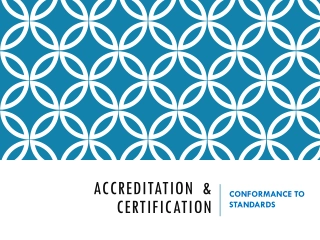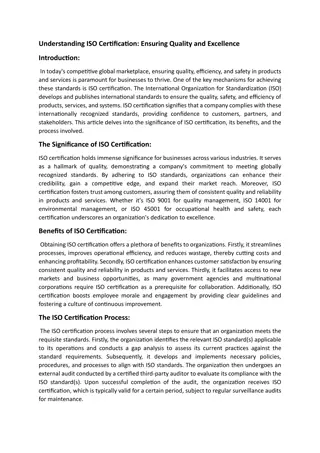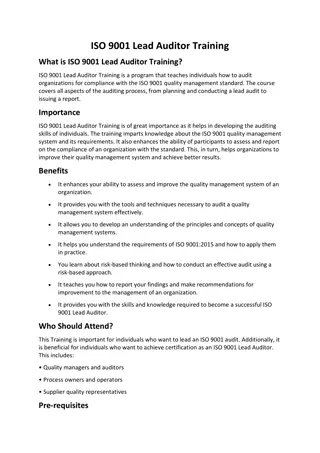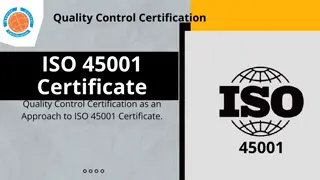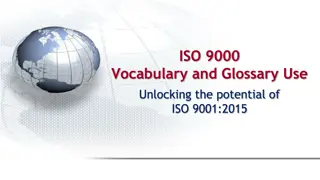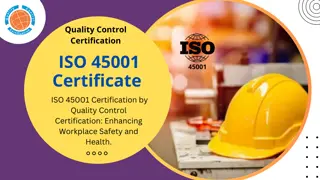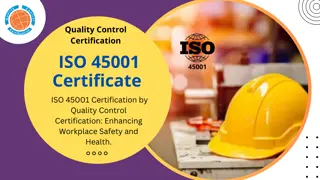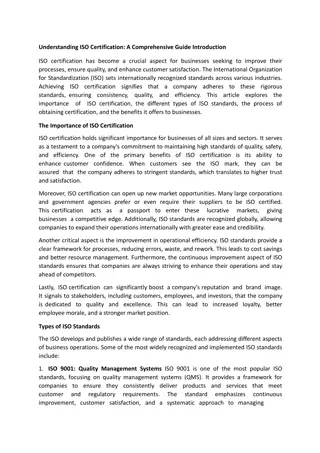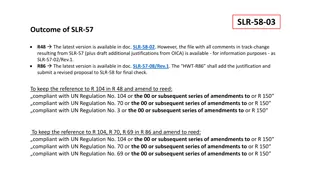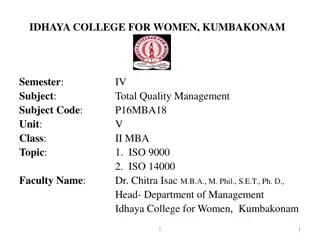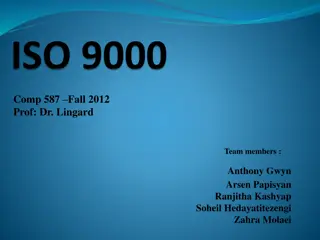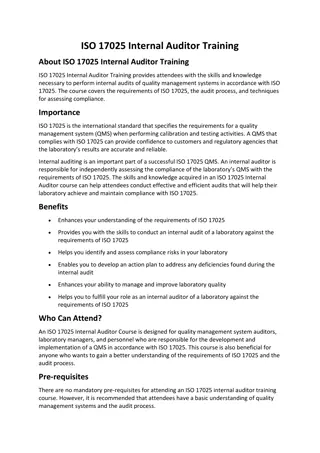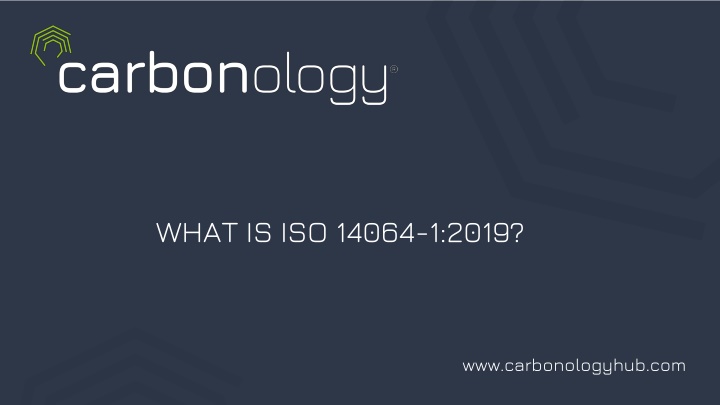
ISO 14064-1:2019 for Greenhouse Gas Emissions
ISO 14064-1:2019 provides guidance for organizations to quantify and report greenhouse gas emissions and removals. It is an international standard allowing businesses of all types to calculate and report on their emissions, as well as actively remove GHGs. By following this standard, companies can demonstrate a credible commitment to reducing emissions and environmental impact.
Download Presentation

Please find below an Image/Link to download the presentation.
The content on the website is provided AS IS for your information and personal use only. It may not be sold, licensed, or shared on other websites without obtaining consent from the author. If you encounter any issues during the download, it is possible that the publisher has removed the file from their server.
You are allowed to download the files provided on this website for personal or commercial use, subject to the condition that they are used lawfully. All files are the property of their respective owners.
The content on the website is provided AS IS for your information and personal use only. It may not be sold, licensed, or shared on other websites without obtaining consent from the author.
E N D
Presentation Transcript
WHAT IS ISO 14064-1:2019? www.carbonologyhub.com www.isologyhub.com
Overview ISO 14064-1:2019 is the specification with guidance at the organisational level for the quantification and reporting of greenhouse gas emissions and removals Put simply, this is the international standard for businesses of all types wanting to calculate and report on their GHG emissions As well as atmospheric emissions, the standard also has provisions for businesses that actively remove GHGs Many companies are falsely claiming to have a strong commitment to the environment and that they are carbon neutral. By using this methodology, you are providing hard and credible evidence of your own commitment. What better way to demonstrate commitment to reducing your emissions than by following an internationally recognised methodology for quantifying them? We will go into more detail on each of the points in this presentation in following modules. This is intended as an introduction.
What is ISO 14064-1:2019? ISO 14064-1:2019 is the Specification with guidance at the organisational level for the quantification and reporting of greenhouse gas emissions and removals In other words, ISO 14064 is a complete and transparent means of accurate quantification of all relevant emissions and removals that uses a consistent framework The internationally recognised standard can be used by organisations of any type or size allowing them to quantify and report on their greenhouse gas (GHG) emissions One of the main outputs of the standard is a GHG Inventory. Here you will categorise emissions and removals of specific GHGs, from specific sources or sinks This standardises both the calculation and reporting format for GHG emissions at the organisational level Calculations Technical requirements and guiding principals Report A universal reporting format in the form of a GHG Report
The Quantification Journey The graphic below gives an overview of the quantification process. We will go into further detail on each of the steps in following training modules and Roadmap workbooks 3. Convert data to tCO2e and manage estimates 1. Define your boundaries What are we quantifying? How do we manage uncertainties? Where is the data coming from? 2. Collect the relevant data Where have we made reductions? 4. Re-Quantify
Getting Started The best way to start is with firm leadership commitment. This enables decision making, allocation of roles and responsibilities, defines a clear goal and provides support for acquiring other necessary resources Next you ll need to define your organisational boundaries (sites), which can be done via two approaches: Control approach account for what you have financial or operational control over (most common) Equity share approach account for your portion of emissions from a facility Next, you ll need to define reporting boundaries (sources) Think about where your largest sources of emissions could be, while being careful to not exclude any significant sources without justification This includes significant direct and indirect emissions that occur as a result of your business activities
Getting Started Once you ve defined your boundaries, there are other important elements of the standard to consider before you begin calculations Intended use(s) Why are you calculating your emissions? Is it to meet mandatory reporting requirements? Are your customers asking for figures and a Carbon Reduction Plan? Do you want to be carbon neutral? Intended user(s) Who will be relying on your outputs to make decisions? What are their needs? Is information accurate and complete enough to enable confident decision making? Responsible party(ies) Who will be responsible for the project, including the provision of data and upkeep of associated documentation? Significance policy How will you define your significant emission sources for your reporting boundaries? This links back to the intended use (e.g. mandatory legal reporting) Uncertainty There will always be a level of uncertainty in results. How do you gauge this and transparently report on it? Estimates and assumptions What estimates and assumptions have you made to arrive at your final results? How do they tie into the level of uncertainty? You will inevitably have to make some estimates during your quantification
Scope 1, 2 and 3 GHG Emissions You will need to classify your emission sources. For ISO 14064 we use Scopes and Categories. We have created a separate CBT to go into more detail on this Activity data is turned into tonnes of specific GHGs using conversion factors, it is a case of multiplying the activity data (e.g. kWh) by the corresponding factor Scope Source Direct GHG emissions and removals Combustion or fugitive emissions (leaks) at sources you own or control 1 Indirect GHG emissions from imported energy - this refers to purchased electricity but can also cover steam for heating 2 3 Other indirect sources Everything else! Scope 3 will likely make up the majority of your emissions
Key Outputs The two documents you will produce as part of an ISO 14064-1 project are the GHG Report and GHG Inventory The GHG Report will contain all your GHG information including: A description of your business and the chosen organisational and reporting boundaries Details of who is responsible for its up-keep Base year and reporting period(s) covered with specific dates Result of your quantification using Scopes and Categories, plus an outline of your methodologies and conversion factors used A statement of conformity in alignment with the standard Details on verification and if this has been completed by a third-party
What are the Benefits to your Organisation? Provides a reliable framework for quantifying your emissions year after year Identifies areas for improvement and enables targets to be set for reductions based on your largest emission sources Save money and improve resource efficiency as a result of greater transparency on your emission sources Demonstrate your commitment to environmental protection to stakeholders by third-party, UKAS accredited verification May also be a tendering requirement and support you with securing new business Supports implementation of further ISO Standards and a useful tool to support any current or future mandatory reporting of emissions
www.carbonologyhub. com www.isologyhub.com

